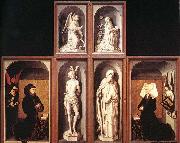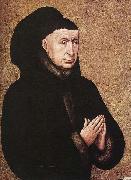
|
WEYDEN, Rogier van der
|
|||
|
|
|||
| Netherlandish Northern Renaissance Painter, ca.1400-1464 | |||
|
|
|||
|
The Last Judgment Polyptych new18/WEYDEN, Rogier van der-629428.jpg Gemälde IDENTIFIZIERUNG:: 51142 |
1446-52 Oil on wood, 215 x 560 cm | ||
|
|
|||
|
WEYDEN, Rogier van der
|
|||
|
|
|||
| Netherlandish Northern Renaissance Painter, ca.1400-1464 | |||
|
|
|||
|
The Last Judgment Polyptych new21/WEYDEN, Rogier van der-457853.jpg Gemälde IDENTIFIZIERUNG:: 63886 |
1446-52 Oil on wood Mus?e de l'H?tel Dieu, Beaune As long as the polyptych hung in its original place, it was traditional to open the wings on Sundays and solemn feast days. But since it has been restored, it is now kept in a neighbouring room which is air-conditioned to prevent any further deterioration due to the heat generated by the three hundred thousand visitors who come to see it each year. The panels were sawn in half across the thickness of the wood a few years ago, and both front and the reverse are now exhibited simultaneously, side by side. The reverse of the panels of the polyptych depict the donors. Nicolas Rolin is an old man, whose nose is too long and whose hair has been cut short. Guigonne de Salins lowers her eyes and gestures with her joined hands towards her book of hours; on her head she wears a starched net veil. Behind each of them, an angel is carrying a shield emblazoned with their respective coats-of-arms. Rolin is facing towards an elegant imitation statue of St Sebastian executed in grey tint, as if carved from marble. His wife is looking towards another imitation statue, this time of St Anthony, who is accompanied by a young pig.Artist:WEYDEN, Rogier van der Title: The Last Judgment Polyptych (reverse side) Painted in 1401-1450 , Flemish - - painting : religious | ||
|
|
|||
|
WEYDEN, Rogier van der
|
|||
|
|
|||
| Netherlandish Northern Renaissance Painter, ca.1400-1464 | |||
|
|
|||
|
The Last Judgment Polyptych new21/WEYDEN, Rogier van der-497572.jpg Gemälde IDENTIFIZIERUNG:: 63887 |
1446-52 Oil on wood Mus?e de l'H?tel Dieu, Beaune The detail shows Chancellor Nicolas Rolin, founder of the H?tel-Dieu in Beaune from one of the outer panels of the Last Judgment Polyptych. The donor of the Hospices de Beaune must have been an extremely powerful and wealthy man to finance such an undertaking. Nicolas Rolin spent nearly sixty of his eighty-one years in the service of the Dukes of Burgundy. For twenty years he was their legal advisor; he spent the remaining years as chancellor. A chancellor in the Middle Ages was a "superminister" combining the functions of Minister of Finance, Home and Foreign Affairs and others. It is not surprising that a capable and intelligent man holding so much power and with more than half a century in the favour of one master, should amass considerable wealth. And that master was no ordinary man. Philippe-le-Bon (Philip the Good), Duc de Bourgogne, Grand Duc d'Occident, could say without exaggeration that "I could be king if I so wished". He was a vassal of the King of France, but infinitely richer and more powerful than the unfortunate Charles VII. Through a series of judicious marriages and annexation of lands after victories, the Dukes of Burgundy, from the days of Jean-Sans-Peur (Fearless John), built up vast spheres of influence, a patchwork of regions and races extending around the Kingdom of France in a crescent from just north of Lyons to just south of Amiens and from there to northern modern Holland. Philippe-le-Bon entrusted the management of this vast domain to Nicolas Rolin. Certain chroniclers contend that his management was not entirely disinterested and that the magnificence of the Hospices directly reflects the degree of his remorse for his actions. Nevertheless, it has been recorded that, assailed by criticism and reproaches and accused of misappropriation of funds, Nicolas Rolin, in order to silence envious tongues, appeared before Philippe-le-Bon dressed in the humble robes of a lawyer with a list in his hand and offered to return all the gifts which the Duke had showered upon him. The Duke refused this offer and was pleased that there was still room on this list for further gifts! There was nothing to indicate that the Rolins, a modest family from Autun, were destined for such greatness. Nicolas needed unrelenting determination and persistence to successfully ascend the social ladder. As Councillor to Jean-Sans-Peur and, after 1422, Chancellor to Phillipe-le-Bon, Nicolas Rolin showed himself to be not only an able administrator but also a canny politician who succeeded in extricating the Duchy of Burgundy from an alliance with the English which became onerous after the glorious progression of Joan of Arc and the change in fortune of Charles VII. He was also one of the authors of the Treaty of Arras, the instrument which reconciled France and Burgundy and ended the Hundred Years' War. Nicolas Rolin's pride and authoritarian nature are clearly reflected in the first words of the charter creating the Hospices, "I wish and hereby order... I wish and hereby devise that... ". In 1443, desirous of helping Beaune, the city of his mother's birth, recover from the devastation of the Hundred Years' War, Nicolas Rolin decided to build a hospital, "ignoring all worldly concerns and in the interests of my salvation ". After the main outlines of his project were established, Rolin, enamoured of the richness of Flemish architecture, imported an artist - thought to have been Jean Wiscrere - from the "flat country" to construct the Hospices in the image of the H?pital Saint-Jacques in Valenciennes. The Chancellor had initially calculated that the work begun in 1443 would take five years. In fact, the building was not dedicated until December 31, 1451. Nicolas and his wife, Guigone de Salins, welcomed six nuns from Flanders the next day and the first patient was admitted several hours later. The last patient left the Hospices in 1971, 520 years later.Artist:WEYDEN, Rogier van der Title: The Last Judgment Polyptych (detail) Painted in 1401-1450 , Flemish - - painting : religious | ||
|
|
|||
|
Also Buy::. For Following Paintings / Artists / Products, Please Use Our Search Online: |








